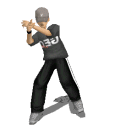The Art of Shaking Hands
By Peter Urs Bender(Published October 2003)
What's in a handshake? As a near-universal gesture of "accommodation" handshaking is a relatively new cultural behavior. Its original purpose was to prove to others you were coming "open-handed" and unarmed. It took off only a few hundred years ago. As far as I know, it was the English we have to give credit for it. The English of that time were world travellers,and the convention spread like wildfire. Right from the start some rules accompanied it. They weren't chiseled in stone, but they were general guides on how to conduct a handshake.There are three main conventions.
1. The way you extend the hand
2. The way you apply the pressure
3. The length of time you shake the hand
>>> More @ Comments Below <<<







1 Comments:
1. The way you extend your hand.
In the olden days it was always the most important person, or the strongest in the group, who had to extend the hand. That has changed. Today, anybody at any place at anytime has the right to offer you his/her hand.
However, whenever you extend your hand, there are three ways of doing it.
* Palm down (you are the one offering it).
If you feel strong and think you "Hold the Whole World in your Hand" you automatically will offer your hand palm down. This forces the other person to offer palm up, and he or he can feel in a "underdog" position. Not very pleasant.
* Palm vertical (let's work together).
The most generous way to offer a handshake is palm vertical. It sends the signal of cooperation. "I want to work with you."
* Palm up (I am fully at your service).
Salespeople often offer a handshake palm up. This is a subtle way of indicating the "at-your-service", aspect of doing business. It says that you, are in charge.
To further emphasize the "I'm at your service, and you, my customer, are truly in charge" aspect, extend your hand vertically, and slowly turn it till your hand is palm up, and the other's is palm down.
Reading this, you may think Bender is full of it. But let me give you a couple of examples.
Let's go to a concert. The violins are always on the right side. Musicians don't just walk up and take a seat. There is a system to everything. The conductor's place is close to the middle. When the musicians are settled, the conductor will enter the room. He or she will go to the kapelmeister, and extend his or her hand, palm vertically. The conductor is greeting the group and wishes for a good performance.
He or she then goes to the podium, takes the baton, and starts the music. Just assume everything went perfectly. When it's all over, the conductor thanks the kapelmeister. However, please watch the position of the hand! Inevitably, after a superb performance, the conductor will extend hand, palm down! I do not think there is a school of conductors where they are instructed on how to shake hands. In such instances, it just comes naturally.
Another example. I used to hold a public speaking contest for Grade 12 high-school students. First prize was $2,500, second, $1,500, and third $1,000. At one of these events one of my licensees took pictures of me handing out the prizes, then sent them to me by mail.When I saw them I nearly fell over. In all the pictures where I gave out the prizes, I had my hand extended palm down, the position of great authority. Consciously and normally, I never do that.
2. The way you apply pressure.
Has nothing to do with honesty, strong character, or anything else. In the western world, professionals encourage their children to give strong handshakes. The child himself won't do it automatically. It has to be taught.
In other parts of the world, however, to apply pressure is regarded as impolite. (It's about the same as if you would go into a business meeting, and somebody would suddenly hug you, because he/she likes you…..)
If a North American woman, with a good firm hand grip goes to the Far East I have to warn her. Taking a man's hand and giving it a firm press, signals him that the woman has a sexual interest. So please do not be surprised, if the man reacts "strangely" to you !
3. The length of time you shake the hand.
This aspect of handshaking is both taught as well as somewhat intuitive. In Canada, in a normal situation, you shake about 4 ½ times and hold the hand a few more seconds. The longer you keep holding the hand, the more powerful you look. However, doing the same in South America it is regarded as rude! You should pump about a dozen times, and hold forever!
If you like someone, you increase the shaking. If you go to a job interview and the interview is over, count the pumps you get. More than four will indicate your interviewer liked you.
Consumption of alcohol will also increase the pumps—about two per drink. Try it out. Go to a party. When you leave count the shakes. The more you and your host like each other the more likely you and he or she will pump the hand of the other.
These observations are not a piece of formal academic research. They are what I have observed from my experience. Try it out yourself. You will find the principles of handshaking are now culturally well-established, and the variations can be fascinating to observe.
Post a Comment
<< Home